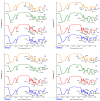Modified Polymeric Biosorbents from Rumex acetosella for the Removal of Heavy Metals in Wastewater
- PMID: 35683864
- PMCID: PMC9183189
- DOI: 10.3390/polym14112191
Modified Polymeric Biosorbents from Rumex acetosella for the Removal of Heavy Metals in Wastewater
Abstract
The contamination of water resources by effluents from various industries often contains heavy metals, which cause irreversible damage to the environment and health. The objective was to evaluate different biosorbents from the weed Rumex acetosella to remove metal cations in wastewater. Drying, grinding and sieving of the stems was carried out to obtain the biomass, retaining the fractions of 250 to 500 µm and 500 to 750 µm, which served to obtain the biosorbents in natura (unmodified), acidic, alkaline, and mixed. Proximal analysis, PZC, TOC, removal capacity, influence of pH, functional groups, thermal analysis, structural characteristics, adsorption isotherms, and kinetic study were evaluated. The 250 µm mixed treatment was the one that presented the highest removal percentages, mainly due to the OH, NH, -C-H, COOH, and C-O functional groups achieving the removal of up to 96.14% of lead, 36.30% of zinc, 34.10% of cadmium and 32.50% of arsenic. For contact times of 120 min and an optimum pH of 5.0, a loss of cellulose mass of 59% at 328 °C and a change in the surface of the material were also observed, which allowed for obtaining a topography with greater chelating capacity, and the Langmuir and pseudo-second order models were better fitted to the adsorption data. The new biosorbents could be used in wastewater treatment economically and efficiently.
Keywords: Rumex acetosella; biosorption; heavy metals; metal removal; modified biomass.
Conflict of interest statement
The authors declare no conflict of interest.
Figures










Similar articles
-
Biosorption of heavy metals by dry biomass of metal tolerant bacterial biosorbents: an efficient metal clean-up strategy.Environ Monit Assess. 2020 Dec 1;192(12):801. doi: 10.1007/s10661-020-08758-5. Environ Monit Assess. 2020. PMID: 33263175
-
Biosorption of lead(II) from aqueous solutions by non-living algal biomass Oedogonium sp. and Nostoc sp.--a comparative study.Colloids Surf B Biointerfaces. 2008 Jul 15;64(2):170-8. doi: 10.1016/j.colsurfb.2008.01.019. Epub 2008 Feb 2. Colloids Surf B Biointerfaces. 2008. PMID: 18321684
-
Biosorption of copper, zinc, cadmium and chromium ions from aqueous solution by natural foxtail millet shell.Ecotoxicol Environ Saf. 2018 Dec 15;165:61-69. doi: 10.1016/j.ecoenv.2018.08.084. Epub 2018 Sep 4. Ecotoxicol Environ Saf. 2018. PMID: 30193165
-
The improved methods of heavy metals removal by biosorbents: A review.Environ Pollut. 2020 Mar;258:113777. doi: 10.1016/j.envpol.2019.113777. Epub 2019 Dec 13. Environ Pollut. 2020. PMID: 31864928 Review.
-
Polysaccharides as Support for Microbial Biomass-Based Adsorbents with Applications in Removal of Heavy Metals and Dyes.Polymers (Basel). 2021 Aug 27;13(17):2893. doi: 10.3390/polym13172893. Polymers (Basel). 2021. PMID: 34502933 Free PMC article. Review.
Cited by
-
Common weeds as heavy metal bioindicators: a new approach in biomonitoring.Sci Rep. 2023 Apr 28;13(1):6926. doi: 10.1038/s41598-023-34019-9. Sci Rep. 2023. PMID: 37117325 Free PMC article.
-
Nanoencapsulation of Phenolic Extracts from Native Potato Clones (Solanum tuberosum spp. andigena) by Spray Drying.Molecules. 2023 Jun 24;28(13):4961. doi: 10.3390/molecules28134961. Molecules. 2023. PMID: 37446623 Free PMC article.
-
Native Potato Starch and Tara Gum as Polymeric Matrices to Obtain Iron-Loaded Microcapsules from Ovine and Bovine Erythrocytes.Polymers (Basel). 2023 Oct 4;15(19):3985. doi: 10.3390/polym15193985. Polymers (Basel). 2023. PMID: 37836034 Free PMC article.
-
Preliminary Assessment of Tara Gum as a Wall Material: Physicochemical, Structural, Thermal, and Rheological Analyses of Different Drying Methods.Polymers (Basel). 2024 Mar 19;16(6):838. doi: 10.3390/polym16060838. Polymers (Basel). 2024. PMID: 38543443 Free PMC article.
-
Stability in Aqueous Solution of a New Spray-Dried Hydrocolloid of High Andean Algae Nostoc sphaericum.Polymers (Basel). 2024 Feb 16;16(4):537. doi: 10.3390/polym16040537. Polymers (Basel). 2024. PMID: 38399913 Free PMC article.
References
-
- Alawady A.R., Alshahrani A.A., Aouak T.A., Alandis N.M. Polysulfone membranes with CNTs/Chitosan biopolymer nanocomposite as selective layer for remarkable heavy metal ions rejection capacity. Chem. Eng. J. 2020;388:124267. doi: 10.1016/j.cej.2020.124267. - DOI
-
- Naseer A., Jamshaid A., Hamid A., Muhammad N., Ghauri M., Iqbal J., Rafiq S., Shah N.S. Lignin and lignin based materials for the removal of heavy metals from waste water-an overview. Z. Phys. Chem. 2019;233:315–345. doi: 10.1515/zpch-2018-1209. - DOI
-
- Zamora-Ledezma C., Negrete-Bolagay D., Figueroa F., Zamora-Ledezma E., Ni M., Alexis F., Guerrero V.H. Heavy metal water pollution: A fresh look about hazards, novel and conventional remediation methods. Environ. Technol. Innov. 2021;22:101504. doi: 10.1016/j.eti.2021.101504. - DOI
LinkOut - more resources
Full Text Sources

